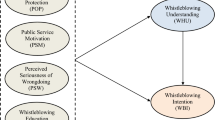Abstract
Scientifically, little is known about white-collar crime in Switzerland or concern about white-collar crime and even less about how concerned bank employees are about this criminality. This article is based on a small opinion survey of Swiss bank employees and tries to explore perceptions of seriousness and concern about white-collar crime among people who, in their position, might have to face this issue regularly. Past assumptions on the public’s indifference towards white-collar crime seem not to be confirmed in this study as the results obtained demonstrate a greater sensitivity with respect to white-collar crime and especially towards crimes perpetrated by corporations. Even though Swiss bank employees do qualify white-collar offences as very serious acts, they are still more punitive with regard to ordinary crimes.



















Similar content being viewed by others
References
Croall, H., (2001). Understanding white-collar crime. Open University Press.
Ferraro, K. & Lagrange R. (1985). The measurement of fear of crime. Sociological Inquiry, 57.
Furstenberg, F. (1971). Public reaction to crime in the streets. The American Scholar, 40/4.
Garofalo, J. (1979). Victimization and fear of crime. Journal of Research in Crime and Delinquency, 16.
Goff, C. & Nason-Clark, N. (1989). The seriousness of crime in Fredrickton: Perception towards white-collar crime. Canadian Journal of Criminology, 31.
Gray, D. & O’Connor M. (1991). Concern about and fear of crime in an Australian rural community. Australian New Zealand J Criminology, 23.
Hindeland, M., Gottfredson, M., & Garofalo, J. (1978). Victims of personal crime: An empirical foundation for a theory of personal victimization. Cambridge, MA: Ballinger.
Hough, M. (1995). Anxiety about crime: findings from the 1994 British Crime Survey. A research and planning unit report. London: Home Office.
Hough, M., & Mayhew, P. (1985). Taking account of crime: Key findings from the Second British Crime Survey. A home office research and planning report. London: HMSO.
Killias, M. (2001). Précis de criminology. Berne: Stämpfli.
Killias, M. & Clerici, C. (2000). Different measures of vulnerability in their relation to different dimensions of fear of crime. British J Criminology, 40.
KPMG (2005). Report, Wirtschaftskriminalität in der Schweiz.
Kuhn, A. & Jayet, A. (2000). Le rôle de l’unité de sanction dans le quantum de la peine, une étude empirique parmi les juges en Suisse. Crimiscope. UNIL.
Kuhn, A., Villettaz, P. & Jayet A. (2002). Opinion publique et sévérité des juges, comparaison entre les peines prononcées par les juges suisses et les sanctions désirées par le public. Crimiscope. UNIL.
Maxfield, M. (1984). The limits of vulnerability in explaining fear of crime: a comparative neighbourhood analysis. J Res Crime Delinquency, 21.
Meier, R. & Short, J. (1985). Crime as hazard, perceptions of risk and seriousness. Criminology, 23.
Mirrlees-Black, C. & Allen, J. (1998). Concern about crime: Findings from the 1998 British Crime Survey. Research Findings 83: Home Office Research.
Pantazis, C., (2000). Fear of crime, vulnerability and poverty, evidence from the British Crime Survey. British J Criminology, 40.
Pantazis, C., & Gordon, D. (1998). Do poor people experience more crime and greater fear of crime than the rich? In D. Dorling, & L. Simpson (Eds.),Statistics in society. London: Arnold.
Rebovich, D. & Layne, J. (2000). The National Public Survey on white-collar crime. National White-Collar Crime Center Report.
Reitze, D. (1986). Urban identification and downtown activities: a social psychological approach. Social Psychology Quarterly, 49/2.
Rossi, P., Waite, E., Rose, C. & Berk R. (1974). The seriousness of crimes: normative structure and individual differences. American Sociological Review, 39.
Silvermann, R. & Kennedy, L. (1985). Loneliness, satisfaction and fear of crime: a test for non-recursive effects. Canadian Journal of Criminology 27/1.
Skogan, W. & Maxfield, M. (1981). Coping with crime: Individual and neighbourhood reactions. Beverly Hills/London. Sage.
Stanko, E. (1995). Women, crime and fear. The Annals of the American Academy of Politics and Social Science, 539.
Warr, E., (1984). Fear of victimization: Why are women and elderly more afraid ? Social Sci Q, 65.
Author information
Authors and Affiliations
Corresponding author
Rights and permissions
About this article
Cite this article
Isenring, G.L. Perception of Seriousness and Concern about White-Collar Crime: Some Results of an Opinion Survey Among Swiss Banks. Eur J Crim Policy Res 14, 371–389 (2008). https://doi.org/10.1007/s10610-008-9081-8
Published:
Issue Date:
DOI: https://doi.org/10.1007/s10610-008-9081-8



